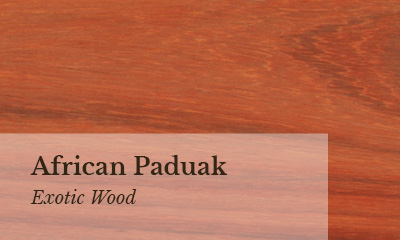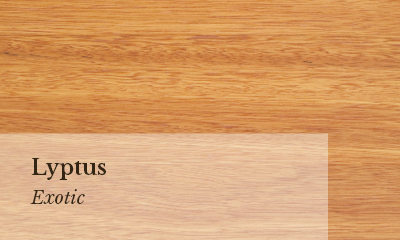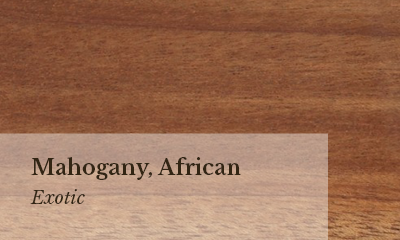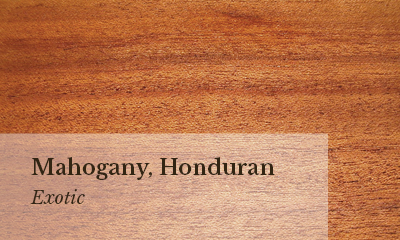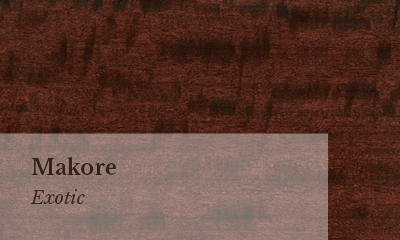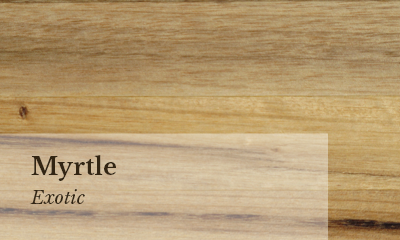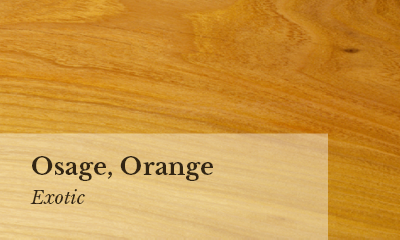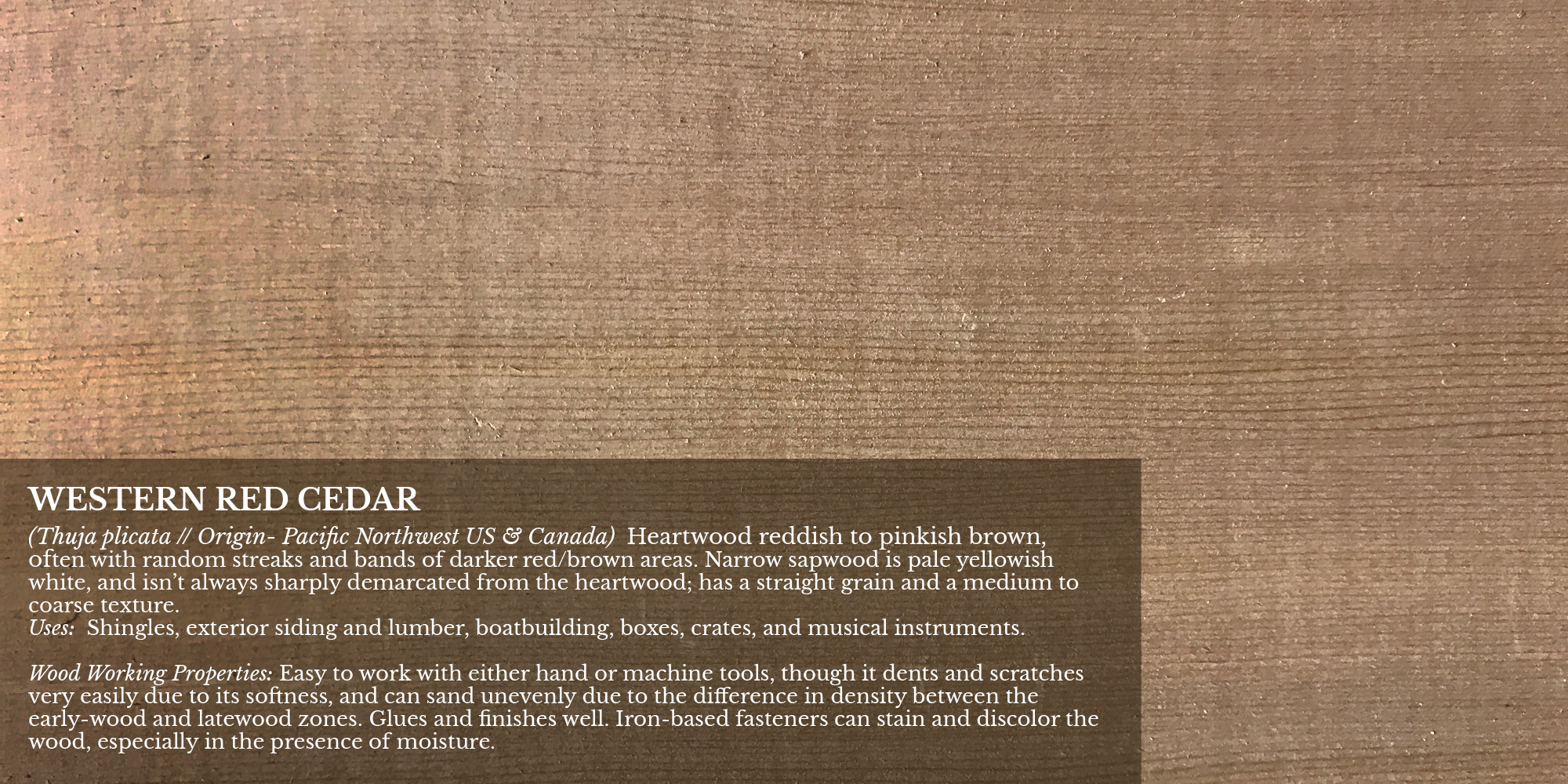Exotic Wood Photos and Descriptions (alphabetical)
Read about Restricted and Endangered Wood Species
Read about Understanding CITES and Banned Woods
We do not keep all of the exotic woods listed on our site in stock. Due to restrictions or limitations of the tree growth, some species may not be available or are in limited sizes or quantities. The photos and descriptions of restricted/limited species are included for reference.
(Pterocarpus soyauxii // Origin- Central and tropical west Africa) Heartwood color can vary, ranging from a pale pinkish orange to a deep brownish red. Most pieces tend to start reddish orange when freshly cut, darkening substantially over time to a reddish/purplish brown. Padauk’s initial orange coloration can be preserved through various finishing procedures.
Uses: Veneer, flooring, turned objects, musical instruments, furniture, tool handles, and other small specialty wood objects.
Woodworking Properties: Overall Padauk is easy to work; tearout may also occur during planning on quartersawn or interlocked grain. Padauk turns, glues, and finishes well
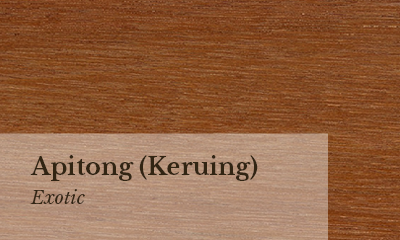
(Dipterocarpus spp. // Origin-Southeast Asia) Heartwood ranges from a light to medium yellowish brown to a darker reddish brown. Overall appearance and grain patterning is rather homogenous and bland.
Uses: Furniture, flooring, trailer decks, and utility lumber.
Wood Working Properties: Generally easy to work with hand or machine tools, though silica present in the wood tends to dull cutters. Also, resin can exude from the wood and build up on tools and also make wood finishing difficult. Movement in service is fairly large.
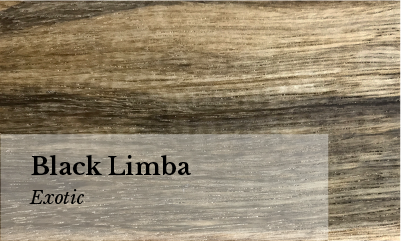
(Terminalia superba // Tropical western Africa) Heartwood is a light yellowish to golden brown, sometimes with grey to nearly black streaks and veins. Wood with such darker figuring is referred to as Black Limba, while plain unfigured wood is called White Limba. Sapwood is a pale greyish to yellowish brown, not clearly demarcated from the heartwood. Color tends to darken with age.
Use: Veneer, plywood, furniture, musical instruments (electric guitar bodies), and turned objects.
Wood Working Properties: Easy to work with both hand and machine tools. Contains a small amount of silica, but blunting effect on cutters is usually small. Glues and finishes well.
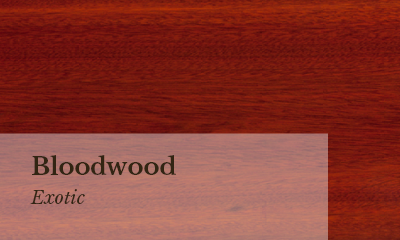
(Brosimum rubescens / Origin- South Africa) Heartwood is a bright, vivid red. Color can darken to a darker brownish red over time with exposure to light. Applying a thick protective finish, and keeping the wood out of direct sunlight can help slow this color shift. Well defined sapwood is a pale yellowish color, though given the typically large trunk diameters, it’s seldom seen or included in imported lumber. Grain is usually straight or slightly interlocked. Has a fine texture with good natural luster, and is also somewhat chatoyant.
Uses: Carvings, trim, inlays, furniture, guitars, knife handles, and turned objects.
Woodworking Properties: Bloodwood is extremely dense, and has a pronounced blunting effect on cutters. The wood tends to be brittle and can splinter easily while being worked. Those persistent enough to bear with the difficulties of working with Bloodwood to the finishing stage are rewarded with an exceptional and lustrous red surface.
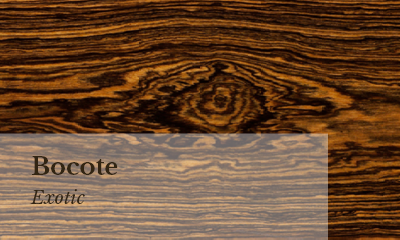
(Cordia spp. //Origin- Mexico and Central/South America) Has a yellowish brown body with dramatic dark brown to almost black stripes. Color tends to darken with age. Also, the grain patterning can be quite striking, particularly on flatsawn areas. It’s not uncommon to see many “eyes” and other figuring in Bocote: though unlike knots, they do not seem to present any special challenges in machining. Grain on most decorative pieces is usually figured in some way, and also tends to be interlocked, though pieces with plain and straight grain can also be found. Medium uniform texture and a naturally oily/waxy feel. Good natural luster.
Uses: Fine furniture, cabinetry, flooring, veneer, boatbuilding, musical instruments, gunstocks, turned objects, and other small specialty wood items.
Woodworking Properties: Some species may contain silica that will dull cutters. On the whole, Bocote is easily worked and machined with good results. Although Bocote has a fairly high amount of natural oils present, gluing is usually problem-free. Bocote also turns and finishes well.
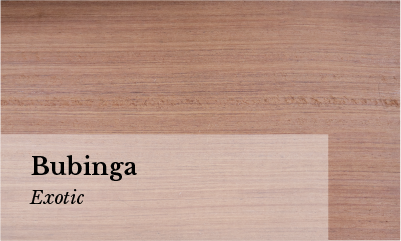
(Guibourtia spp. // Origin-Africa, around the equator) Heartwood ranges from a pinkish red to a darker reddish brown with darker purple or black streaks. Sapwood is a pale straw color and is clearly demarcated from the heartwood. Bubinga is very frequently seen with a variety of figure, including: pommele, flamed, waterfall, quilted, mottled, etc. Grain is straight to interlocked. Has a uniform fine to medium texture and moderate natural luster.
Uses: Veneer, inlays, fine furniture, cabinetry, turnings, and other specialty items. Since Bubinga trees can grow so large, natural-edge slabs of the wood have also been used in tabletops and other specialized projects.
Woodworking Properties: Easy to work overall, though depending upon the species Bubinga can have silica present, which can prematurely dull cutting edges. Also, on pieces with figured or interlocking grain, tearout can occur during planing or other machining operations. Gluing can occasionally be problematic due to Bubinga’s high density and natural oils. Turns and finishes well.
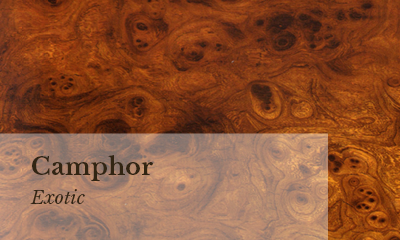
(Cinnamomum camphora // Origin-Southeast Asia, but planted in tropical regions around the globe) Color can be highly variable depending on species and growing conditions; generally a light brown, frequently with shades of gray, red, or olive green. Occasionally contains darker streaks. Paler sapwood isn’t always clearly differentiated from the heartwood. Grain can be straight, interlocked, and/or wavy. Uniform medium texture with a high natural luster and a slightly greasy feel. Prices for such “domestic” exotics are usually in the moderate range when compared to other imported hardwoods. . Burls are also commonly seen, and are considered highly decorative. Solid burls and veneer sheets are much more expensive.
Uses: Veneer, turned objects, chests, cabinetry, and furniture.
Woodworking Properties: Camphor’s moderate density makes it easy to shape and machine with minimal effort. Areas of interlocked grain may cause tear-out issues, but complications are usually minimal. Glues and finishes well.
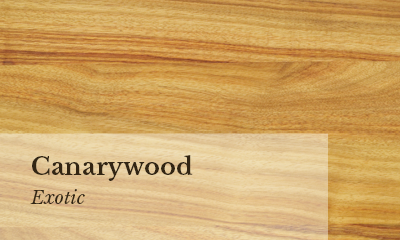
(Centrolobium spp. // Origin- South America) Rated as very durable in regard to decay resistance, as well as being resistant to termite and marine borer attack. Heartwood color can vary a fair amount, from a pale yellow-orange to a darker reddish brown, usually with darker streaks throughout. Pale yellow sapwood is sharply demarcated from heartwood. Color tends to darken and homogenize with age. Some pieces of Canarywood can be almost rainbow colored—with dark red streaks, along with the natural orange, yellow, and brown coloration.
Uses: Construction lumber, railroad crossties, flooring, veneers, boatbuilding, furniture, cabinetry, and turned items
Woodworking Properties: Easy to work with both hand and machine tools, though some tearout can occur during planing on pieces with wild or irregular grain. Good dimensional stability. Turns, glues and finishes well.
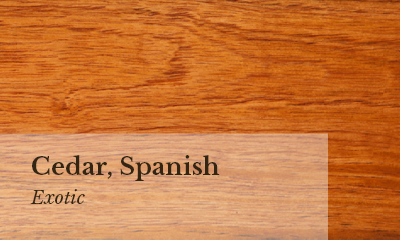
(Cedrela odorata // Origin-Central and South America and the Caribbean; also grown on plantations) Not a true cedar, Spanish Cedar is actually more closely related to true Mahoganies. Heartwood is a relatively uniform light pinkish to reddish brown; colors tend to darken with age. Random pockets of gum and natural oils are commonly present. Grain patterning and figure tends to be somewhat bland. Some of the wood available at present comes from plantations: where younger, faster-growing trees, produce wood that is lower in density, and paler in color than wood cut from trees taken from forests in the wild.
Uses: Veneer, plywood, cabinetry, musical instruments, (flamenco and classical guitars), humidors, and boatbuilding.
Woodworking Properties: Spanish Cedar is easy to work with both hand and machine tools. However, due to its low density and softness, Spanish Cedar tends to leave fuzzy surfaces if not machined with sharp cutters; extra sanding up to finer grits may be required to obtain a smooth wood surface. Also, natural gum pockets can remain wet and may ooze out onto the surrounding surface, which can clog and gum up saw blades, and make finishing the wood a challenge.
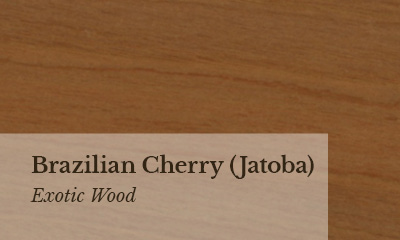
(Hymenaea courbaril // Origin- Central America, southern Mexico, northern South America, and the West Indies) Also known as Jatoba. Heartwood varies from a light orangish brown to a darker reddish brown, sometimes with contrasting darker grayish brown streaks. Color tends darken upon exposure to light. Sapwood is a light grayish yellow, clearly demarcated from the heartwood. Available in satisfactory sizes and widths as lumber, and also available as flooring planks. Jatoba is inexpensive for an imported timber.
Uses: Flooring, furniture, cabinetry, tool handles, shipbuilding, railroad ties, turned objects, and other small specialty items.
Woodworking Properties: Jatoba is considered difficult to work with on account of its density and hardness, and has a moderate blunting effect on tool cutters. Jatoba also tends to be difficult to plane without tear-out due to its interlocking grain. However, Jatoba glues, stains, turns, and finishes well. Responds well to steam-bending.
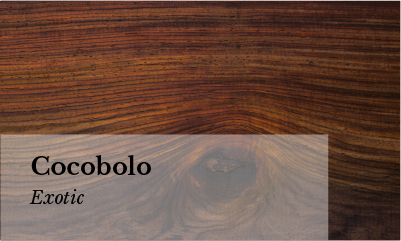
(Dalbergia retusa // Origin-Central America) Cocobolo can be seen in a kaleidoscope of different colors, ranging from yellow, orange, red, and shades of brown with streaks of black or purple. Sapwood is typically a very pale yellow. Colors are lighter when freshly sanded/cut, and darken with age. Grain is straight to interlocked, with a fine even texture. Good natural luster. This species is on the Red List and is difficult to acquire due to a population reduction of over 20% in the past three generations, caused by a decline in its natural range, and exploitation.
Uses: Fine furniture, musical instruments, turnings, and other small specialty objects.
Woodworking Properties: Due to the high oil content found in this wood, it can occasionally cause problems with gluing. Also, the wood’s color can bleed into surrounding wood when applying a finish, so care must be taken on the initial seal coats not to smear the wood’s color/oils into surrounding areas. Tear-out can occur during planing if interlocked grain is present; the wood also has a moderate blunting effect on cutting edges/tools due to its high density. Cocobolo has excellent turning properties.
* Cocobolo is in limited supply, and is also in relatively high demand, (for ornamental purposes), and is likely to be quite expensive. Prices should compare similarly to other rosewoods in the Dalbergia genus.
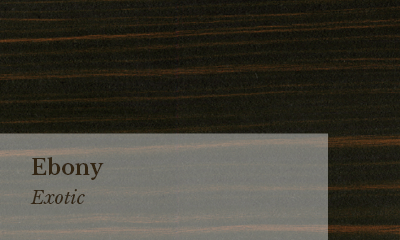
(Gaboon Ebony, African Ebony) (Diospyros crassiflora // Origin-West Africa Equator) Heartwood is usually jet-black, with little to no variation or visible grain. Occasionally dark brown or grayish-brown streaks may be present.
Uses: Small/ornamental items, such as piano keys, musical instrument parts, pool cues, carvings, and other small specialty items.
Woodworking Properties: Can be difficult to work due to its extremely high density. Has a dulling effect on cutters. Tearout may occur on pieces that have interlocked or irregular grain. Due to the high oil content found in this wood, it can occasionally cause problems with gluing. Finishes well, and polishes to a high luster. Responds well to steam bending.
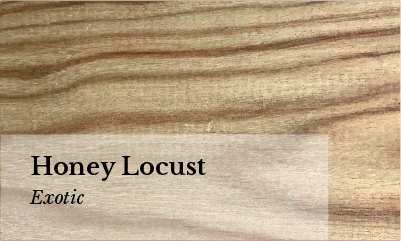
(Gleditsia triacanthos // South-central and eastern United States) Heartwood is a medium to light reddish brown. Wide sapwood is a light yellow, clearly distinguished from the heartwood. Very similar in appearance to Kentucky Coffeetree. Grain is usually straight or slightly irregular, with a medium uneven texture. Moderate natural luster.
Uses: Furniture, fence posts, utility lumber, and turned objects.
Wood Working Properties: Honey Locust can be difficult to work with hand and machine tools on account of its density, though it generally produces good results. Turns, glues, stains, and finishes well.
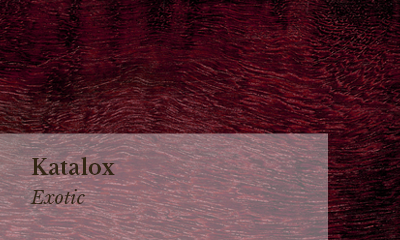
(Swartzia spp. // Origin-Southern Mexico, Central America, and Northern South America) Heartwood is dark reddish brown to nearly black, sometimes with a strong purple hue. Sapwood is sharply demarcated and is pale yellowish white. Pieces with curly or wavy grain are not uncommon. Katalox has exceptional strength properties, and is among the very stiffest and strongest woods available worldwide.
Uses: Inlays, fine furniture and cabinetry, parquet flooring, guitars, turnings, and other small specialty items.
Woodworking Properties: Katalox is typically considered difficult to work on account of its high density. The wood has a moderate to high blunting effect on cutters, and if there is interlocked grain present, tear-out can occur during planing. Can be troublesome to glue because of its high density and natural oils present.
* Usually available in turning squares or as figured lumber (generally with a large amount of sapwood present). Expect prices to be in the mid to upper range for an imported tropical hardwood.
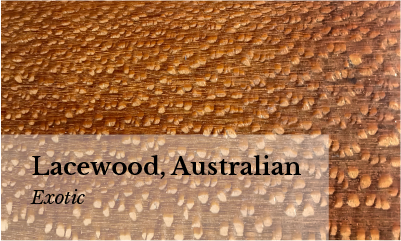
(Panopsis spp. // Origin-Tropical South America) Has a very conspicuous flecking that gives this wood its namesake. The wood itself is a reddish brown with grey or light brown rays, which result in a lace pattern when quartersawn. Like other woods that exhibit the strongest figure in quartersawn pieces, Lacewood has the most pronounced figure and displays the largest flecks when perfectly quartersawn; this is due to the wood’s wide medullary rays, whose layout can be seen the clearest when looking at the endgrain.
Uses: Veneer, cabinetry, fine furniture, musical instruments (guitars), and turned objects.
Woodworking Properties: Overall a fairly easy wood to work with, taking glues, stains, and finishes well; though there may be some difficulty in planning, with tearout occurring. Some species of lacewood can also have a moderate blunting effect on cutting edges.
(Eucalyptus urograndis (Eucalyptus grandis x E. urophylla hybrid // Origin-) Color ranges from a lighter salmon pink to a darker brownish red. Appearance has been likened to both Black Cherry and Honduran Mahogany. Color tends to deepen with age. Has a medium texture and small to medium sized open pores. The grain tends to be straight and even. Also, since the wood is grown and pruned on a plantation, there tends to be few knots or other abnormal grain patterns.
Uses: Flooring, lumber, interior millwork, cabinetry, plywood, and turned objects.
Wood Working Properties: Generally easy to work, though it can burn easily. Glues, stains, and finishes well.
(Khaya anthotheca, K. grandifoliola, K. ivorensis, K. senegalensis // Origin-West tropical Africa) Heartwood color is variable, ranging from a very pale pink to a deeper reddish brown, sometimes with streaks of medium to dark reddish brown. Color tends to darken with age. Quartersawn surfaces can also exhibit a ribbon-stripe appearance. Grain is straight to interlocked, with a medium to coarse texture. Good natural luster with a light-refracting optical phenomenon known as chatoyancy. Readily available in a variety of lumber sizes, as well as plywood and veneer. Prices are low to moderate for an imported hardwood.
Uses: Veneer, plywood, turned items, furniture, boatbuilding, and interior trim.
Woodworking Properties: Easy to work, glue, and finish. Tearout can sometimes be a problem if the grain is interlocked.
(Swietenia macrophylla // Origin-Southern Mexico to Central South America) Swietenia macrophylla is what most consider to be the real and true species when referring to “Mahogany.” Heartwood color can vary a fair amount with Honduran Mahogany, from a pale pinkish brown, to a darker reddish brown. Color tends to darken with age. Mahogany also exhibits an optical phenomenon known as chatoyancy.
Uses: Furniture, cabinetry, turned objects, veneers, musical instruments, boatbuilding, and carving
Wood working Properties: Typically very easy to work with tools: machines well. Slight dulling of cutters can occur. Sands very easily. Turns, glues, stains, and finishes well.
(Tieghemella heckelii // Origin- Western and Middle Africa) Heartwood pink or reddish brown, sometimes with streaks of mild color variation. Yellowish sapwood. Figured grain patterns (such as mottled or curly) are a common occurrence.
Uses: Veneer, plywood, furniture, cabinetry, flooring, boatbuilding, musical instruments, turned objects, and other small wooden specialty items.
Woodworking Properties: Generally easy to work, though sections with interlocked grain can cause tear-out during planning.
(Umbellularia californica // Origin-Coastal regions of sowthwest Oregon and central California) Heartwood color can be variable, from light orangish brown to gray or olive, sometimes with darker streaks present. Pale sapwood is usually well defined. Figured grain patterns (curly, mottled, burl) are not uncommon.
Uses: Veneer, cabinetry, fine furniture, musical instruments (guitar backs), interior trim, gunstocks, turned objects, and other small specialty items.
Woodworking Properties: Fairly easy to work, though tearout can occur on pieces with figured grain. Has a tendency to burn during drilling and routing, and appropriate speeds and sharp cutters are recommended. Turns, glues, and finishes well.
(Maclura pomifera // Origin- South-central United States) Heartwood is golden to bright yellow, which inevitably ages to a darker medium brown with time: primarily due to exposure to ultraviolet light. Grain is straight, with a fine to medium texture. High natural luster.
Uses: Fence posts, dye, archery bows, musical instruments, turnings, and other small specialty wood items.
Woodworking Properties: Working this Osage Orange can be difficult due to its hardness and density, though it is reported to have little dulling effect on cutting edges. It turns well, and also takes stains, glues and finishes well.
* Having typically small, crooked, and knotty trunks, Osage Orange isn’t usually harvested for lumber, but can occasionally be found for sale in either board or small turning block form. Due to its domesticity and adequate supply, the price should be moderate, though likely to be higher than most other native lumbers on account of its “specialty” status.
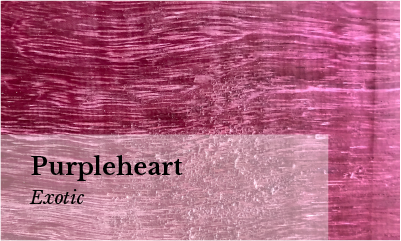
(Peltogyne spp. // Origin-Central & South America) When freshly cut the heartwood of Purpleheart is a dull grayish/purplish brown. Upon exposure the wood becomes a deeper eggplant purple. With further age and exposure to UV light, the wood becomes a dark brown with a hint of purple.
Uses: Inlays/accent pieces, flooring, furniture, boatbuilding, heavy construction, and a variety of specialty wood items.
Woodworking Properties: Working with Purpleheart can present some unique challenges: if the wood is heated with dull tools, or if cutter speeds are too high, Purpleheart will exude a gummy resin that can clog tools and complicate the machining process. Depending on the grain orientation, can be difficult to plane without tear-out. Purpleheart also has a moderate dulling effect on cutters.
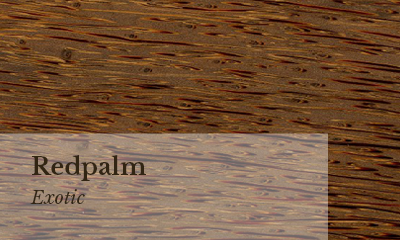
(Cocos nucifera // Origin-tropical regions worldwide) Reddish brown fibers embedded in a lighter tan or light brown colored body. Fibers are more densely packed toward the outside of the tree trunk, becoming more and sparser toward the center of the tree. The center core of the tree is soft and contains none of the darker vascular bundles that give the wood its characteristic look and hardness. (This is nearly opposite of the typical outer sapwood/inner heartwood combination found in dicot hardwoods.)
Uses: Flooring, canoes, rafts, walking sticks, knife and tool handles, carvings, rafters, furniture, and turned objects.
Woodworking Properties: Tends to be quite difficult to work with both machine and hand tools. The hard fibers contrast with the soft body of the wood, and can be brittle and splinter or pull out. Very sharp tools and correct cutting angles are required to get clean results. Applying a hardener or sanding sealer prior to final sanding/machining may help give a more homogenous density and reduce tearout. The lighter colored body of the wood tends to absorb larger quantities of finish, so care must be taken during finishing; a sanding sealer is recommended.
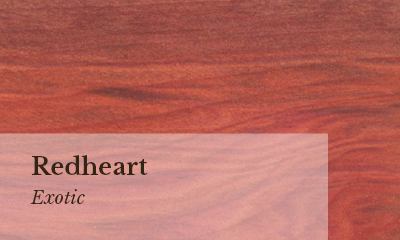
(Erythroxylum spp. and Simira spp. // Origin-Southern Mexico to southern Brazil and Paraguay) Aptly named, in some instances freshly surfaced Redheart can be a very bright, watermelon red—though color can vary in intensity and hue from board to board: anywhere from a light orange/pink to a darker brownish red. In some cases, it can look quite similar to Bloodwood, though usually with a more visible and figured grain pattern. Redheart’s vibrant color quickly fades to a reddish brown in direct sunlight.
Uses: Turned objects, inlays, veneer, fine furniture, and small specialty wood items.
Woodworking Properties: Redheart has good working characteristics, and planes, machines, and sands well. Turns, glues, and finishes well.
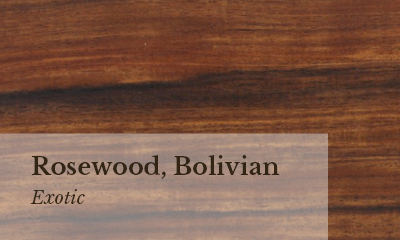
(Pau Ferro)( Machaerium spp. // Origin- Tropical Sount America –Brazil & Bolivia mostly) Color can be highly varied, ranging from reddish/orange to a dark violet/brown, usually with contrasting darker black streaks. Narrow sapwood is a pale yellow and is clearly demarcated from the heartwood.
Uses: Veneer, musical instruments, cabinetry, flooring, interior trim, turning, and other small specialty wood objects.
Woodworking Properties: Pau Ferro is considered overall to be of fair workability, as it can blunt the cutting edges of tools, and any irregular grain has a tendency to tearout during machining operations. Also, many of the same challenges in gluing rosewoods are common to Pau Ferro as well. Pau Ferro turns and finishes well.
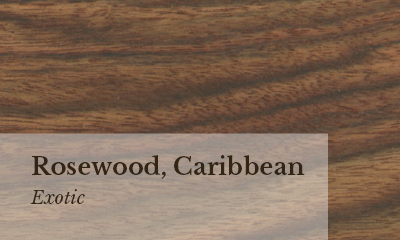
(Chechen)( Metopium brownie // Origin- Dominican Republic, Cuba, Jamaica, Guatemala, Belize, and southeastern Mexico) Heartwood color is highly varied, with red, orange, and brown contrasted with darker stripes of blackish brown. Color tends to shift to a darker reddish brown with age. Well defined sapwood is a pale yellow.
Uses: Veneer, furniture, cabinetry, flooring, turned objects, and small specialty wood items.
Woodworking Properties: Fairly easy to work, but tearout may occur when machining pieces with interlocked grain. Glues and finishes well, though because of its density and tendency to split, nails and screws should be pre-bored.
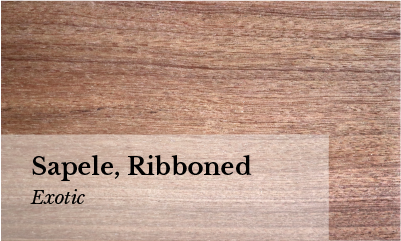
(Entandrophragma cylindricum // Origin-Tropical Africa) Heartwood is a golden to dark reddish brown. Color tends to darken with age. Besides the common ribbon pattern seen on quartersawn boards, Sapele is also known for a wide variety of other figured grain patterns, such as: pommele, quilted, mottled, wavy, beeswing, and fiddleback.
Uses: Veneer, plywood, furniture, cabinetry, flooring, boatbuilding, musical instruments, turned objects, and other small wooden specialty items.
Woodworking Properties: Sapele can be troublesome to work in some machining operations, (i.e., planing, routing, etc.), resulting in tear out due to its interlocked grain. It will also react when put into direct contact with iron, becoming discolored and stained. Sapele has a slight blunting effect on cutters, but it turns, glues, and finishes well.
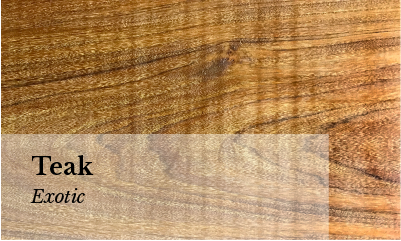
(Tectona grandis // Origin-Southern Asia) Heartwood tends to be a golden or medium brown, with color darkening with age.
Uses: Ship and boatbuilding, veneer, furniture, exterior construction, carving, turnings, and other small wood objects.
Woodworking Properties: Easy to work in nearly all regards, with the only caveat being that Teak contains a high level of silica (up to 1.4%) which has a pronounced blunting effect on cutting edges. Despite its natural oils, Teak usually glues and finishes well, though in some instances it may be necessary to wipe the surface of the wood with a solvent prior to gluing/finishing to reduce the natural oils on the surface of the wood.
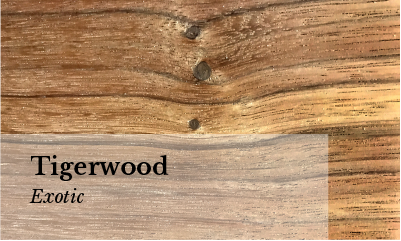
(Astronium graveolens // Origin-Mexico to Brazil) Grain can be straight, but is usually wavy or interlocked. Fine, uniform texture with good natural luster. Heartwood is typically a medium reddish brown with irregularly spaced streaks of dark brown to black. Color tends to darken with age. The wood has superb stiffness, strength, hardness, and durability. However, density and other mechanical properties can vary widely depending on the growing site and source region. The name “Jobillo” is sometimes used to refer to higher grades of Goncalo Alves among woodturners.
Uses: Flooring, veneers, furniture, cabinetry, carving, turned objects, and other small wood specialty objects such as: pool cues, archery bows, knife handles, etc.
Woodworking Properties: Goncalo Alves is generally not too difficult to work, despite its high density. Figured pieces with irregular grain can pose a challenge in planing and machining operations. Goncalo Alves can also have a moderate blunting effect on cutters. The wood is very resistant to moisture absorption, which can make it difficult to glue. Goncalo Alves turns and finishes well.
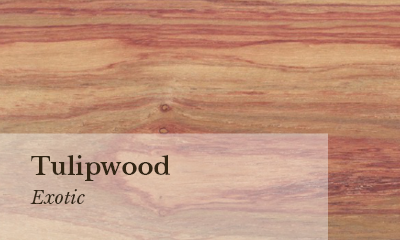
(Dalbergia decipularis // Origin-Northeastern Brazil) Heartwood is streaked with yellows, reds, oranges, and pinks. Color and figure can be highly variegated. Reported as having a low decay resistance, although it is resistant to insect attack.
Uses: Veneer, fine furniture, inlay, marquetry, musical instruments (percussion), and small turned objects.
Woodworking Properties: Tends to be difficult to work due to its high density; also has a blunting effect on cutters. Can be difficult to glue do to an abundance of natural oils and high density. Turns very well and takes a high polish.
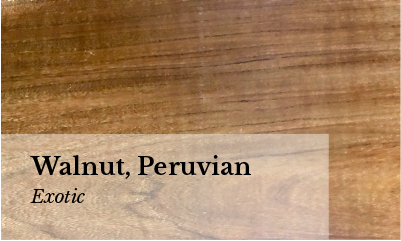
(Juglans spp. (Juglans australis, J. neotropica, J. olanchana, etc. // Origin- Southern Mexico, Central and South America) Heartwood tends to be darker than temperate walnut species, with a deep chocolate brown color, sometimes with a purplish hue. May also contain streaks of lighter-colored wood mixed throughout the heartwood, which can sometimes be extensive and result in a high degree of waste. Grain figuring such as curl seems to be much less common than other walnut species.
Uses: Furniture, cabinetry, veneers, flooring, musical instruments, and interior trim.
Wood Working Properties: Typically easy to work provided the grain is straight and regular. Planer tear-out can sometimes be a problem when surfacing pieces with irregular or figured grain. Glues, stains, and finishes well.
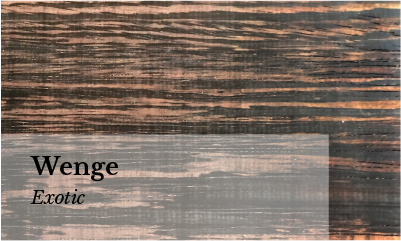
(Millettia laurentii // Origin-Central Africa) Heartwood is medium brown, sometimes with a reddish or yellowish hue, with nearly black streaks. Upon application of a wood finish (particularly an oil finish) the wood can become nearly black.
Uses: Veneer, paneling, furniture, turned objects, and musical instruments.
Woodworking Properties: Can be difficult to work with hand and machine tools. Blunts tool edges. Sands unevenly due to differences in density between light and dark areas. Very splintery—care must be used when handling unfinished wood with bare hands, as splinters have an increased risk of infection. Very large pores can be difficult to fill if a perfectly smooth/level finish is desired.
*Read about Restricted and Endangered Wood Species
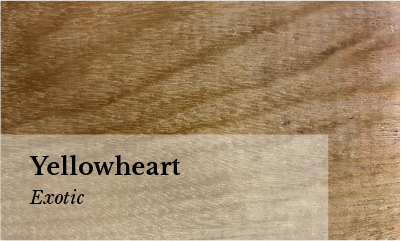
(Euxylophora paraensis // Origin- Brazil) Heartwood color ranges from pale to golden yellow, darkening only slightly with age. Sapwood is a pale yellow/white.
Uses: Flooring, furniture, boatbuilding, accents, and turned objects.
Woodworking Properties: Yellowheart is normally easy to work with hand or machine tools, though it can be more difficult if interlocked or figured grain is present. Yellowheart also has a moderate blunting effect on cutters. Glues and finishes well.
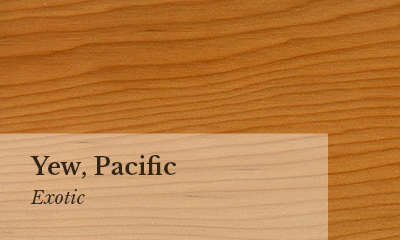
(Taxus brevifolia // Origin-Pacific Northwest North America) Sapwood is usually a thin band of pale yellow or tan color, while the heartwood is an orangeish-brown, sometimes with a darker brown or purplish hue. Color tends to darken with age.
Uses: Bows (archery), veneer, cabinetry, furniture, carvings, musical instruments (lutes), and turned objects.
Woodworking Properties: Overall, an easy wood to work, though knots and other grain irregularities can pose a challenge. Yew glues, finishes, and turns well.
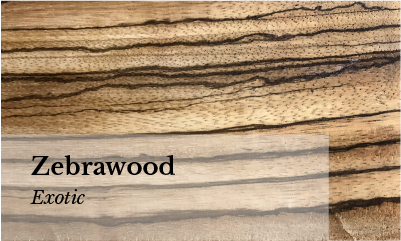
(Microberlinia brazzavillensis // Origin-West Africa) Heartwood is a light brown or cream color with dark blackish brown streaks vaguely resembling a zebra’s stripes. Depending on whether the wood is flatsawn or quarter sawn, the stripes can be either chaotic or wavy (flatsawn), or somewhat uniform (quarter sawn).
Uses: Zebrawood is frequently quarter sawn and used as veneer. Other uses include: tool handles, furniture, boatbuilding, and skis.
Woodworking Properties: The wood saws well, but can be very difficult to plane or surface due to the prevalence of interlocking grain. Tear out is common. Zebrawood glues and finishes well, though a transparent pore filler may be necessary for the large open pores which occur on both dark and light surfaces.
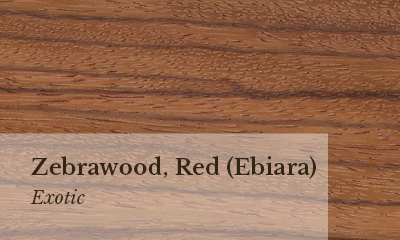
[Berlinia spp. (B. auriculata, B. bracteosa, B. confusa, and B. grandiflora) // Origin-West Africa] Also known as: Ebiara, Berlinia, Poculi. Heartwood color ranges from golden yellow brown to a deeper reddish brown, frequently with darker black streaks and stripes. Paler sapwood is clearly demarcated from the heartwood.
Uses: Veneer, furniture, cabinetry, turned objects, and other small specialty wood items.
Wood Working Properties: Generally easy to work with hand or machine tools, though planning or surfacing interlocked grain may result in tear-out, particularly on quarter sawn surfaces. Glues, turns, and finishes well.
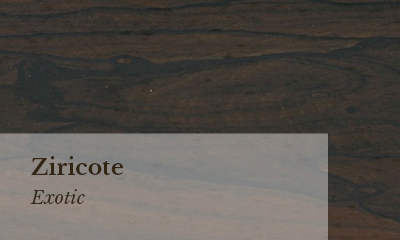
(Cordia dodecandra // Origin-Central America and Mexico) Color ranges from medium to dark brown, sometimes with either a green or purple hue, with darker bands of black growth rings intermixed. Ziricote has a very unique appearance, which is sometimes referred to as “spider-webbing” or “landscape” grain figure. Quartersawn surfaces can also have ray flakes similar in appearance to those found on quartersawn Hard Maple. The pale yellowish sapwood is sometimes incorporated into designs for aesthetic effect, or to cut down on wastage.
Uses: Furniture, veneer, cabinetry, gunstocks, musical instruments (acoustic and electric guitars), turned objects, and other small specialty wood items.
Woodworking Properties: Overall, Ziricote is fairly easy to work considering its high density. The wood tends to develop end and surface checks during drying, which can be problematic: though the wood is stable once dry. Also, pieces are usually available in narrow boards or turning squares, with sapwood being very common. Ziricote turns and finishes well, and in most instances, it can also be glued with no problems. (On rare occasions, the wood’s natural oils can interfere with the gluing process.)







